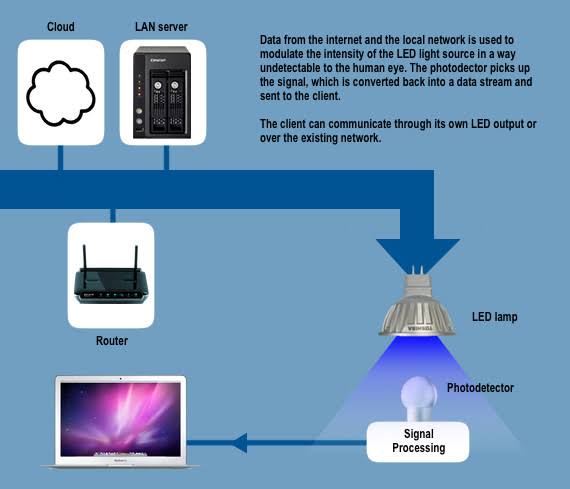Light-emitting diodes, or LEDs, are used in Li-Fi, or Light Fidelity, an innovative wireless optical networking technology, to transmit data. Li-Fi uses visible light communication (VLC) to send data wirelessly, just like Wi-Fi uses radio waves to do so. Up to 100 times quicker wireless connections than Wi-Fi might be possible with Li-Fi. This post will go into great detail on Li-Fi, including understanding what is Lifi, its functions, benefits over Wi-Fi, uses, and potential future developments.
What is Li-Fi?
Light Fidelity is referred to as Li-Fi. It is a wireless optical networking technique that transmits data using light-emitting diodes (LEDs). Similar to traditional Wi-Fi, which transmits data wirelessly via radio waves, Li-Fi accomplishes the same goal but communicates by visible light. It can be compared to the wireless variant of Wi-Fi, except that data is sent using the light produced by LED lights rather than radio waves. Li-Fi networks provide a number of benefits over conventional Wi-Fi networks. It does not interfere with other wireless networks, such as Bluetooth, and has a far larger bandwidth capacity. It provides more security because light cannot penetrate through walls and the signal cannot be accessed from outside of rooms. Additionally, it does not pose any health risks related to radio waves.
How does Li-Fi work?
LED lights are used in Li-Fi systems to transmit data wirelessly. LED lights have the ability to flicker on and off at incredibly fast speeds that are undetectable to the human eye. This quick flashing encodes digital data (binary code zeros and ones) that photodetectors (receivers) may pick up and decode into audio-visual signals. A photodetector, which serves as the receiver to detect light signals as well as convert them into electrical signals, an LED lamp or bulb, which acts as the transmitter by flickering at very high speeds, and a microprocessor, which processes the electrical signals and decodes the data, are the essential parts of a Li-Fi system. The LED light bulb only shines when it is on for a very little period of time and off for an equally brief period of time in order to send data. The binary code is represented by the on-off patterns, which the photodetector detects and translates into electrical signals so the computer can decode and retrieve the original data.
Advantages of Li-Fi over Wi-Fi
Li-Fi networks provide a number of significant benefits over traditional Wi-Fi networks. First off, one of Li-Fi’s main benefits is speed. Unlike Wi-Fi, which uses radio frequencies, Li-Fi has a far broader bandwidth as it employs the whole visible light spectrum for data transmission. This makes it possible for Li-Fi to reach rates more than 1 Gbps, or around 100 times quicker than the fastest Wi-Fi networks available today.
Second, compared to Wi-Fi, Li-Fi offers a significant security benefit. Li-Fi is far more secure since its signals can’t go through walls and can only operate in the space where the light source is. Wi-Fi signals may be hijacked from outside places and can flow through barriers. Private information is only accessible inside the lit area while using Li-Fi.
Applications of Li-Fi
Because Li-Fi technology offers benefits over Wi-Fi, it has various possible uses. Li-Fi can securely provide high-speed wireless connection in offices by utilizing the current LED lighting infrastructure. Li-Fi networks are more secure than conventional Wi-Fi networks since connections can only be made within the room limits because Li-Fi signals cannot pass through walls.
Li-Fi technology can be connected to traffic lights, street lamps and other outdoor lighting sources to establish public hotspots for Li-Fi. With this, people will be able to surf the Internet with their mobile devices while walking along the street. Installing Li-Fi networks in indoor public spaces such as shopping malls, airports and hospitals will provide afflicted people and visitors with alternative means of interference free connectivity.
Future of Li-Fi technology
The future of Li-Fi seems bright as the technology progresses and becomes more mainstream. Advances in LED and photodetector technology mean that over the coming years Li-Fi speeds should skyrocket. Current Li-Fi speeds are about 1 Gbps, but within the next five to ten years rates of over 10 Gbps can be achieved. Now, Li-Fi promises to deliver wireless Net speeds even faster than most of the wired broadband options.
Over the years, Li-Fi lighting fixtures will change. They will contain micro-optics and cutting-edge sensors which allow restricted movement in illuminated interior space. Users will still be able to maintain connectivity as they switch between the different light sources. This opens up room for the experience of true mobile and continuous high-speed connectivity.
Conclusion
Li-Fi is a new wireless communication technology that its proponents say offers several times the connectivity options of Wi-Fi. If further developed and accepted commercially, how Lifi works has a chance to become the next wireless standard for requirements associated with fast, secure connections that do not interfere. Although Li-Fi is still in development, it looks ready to revolutionize the way we send and receive data wirelessly.

































